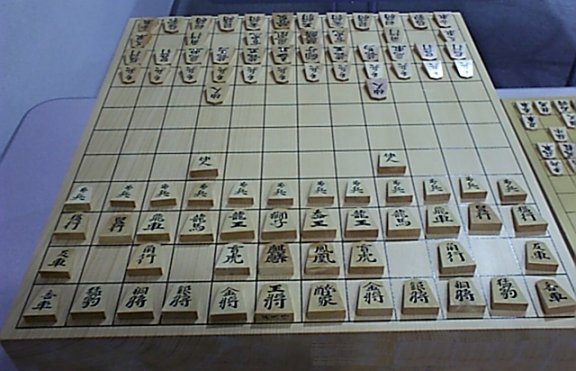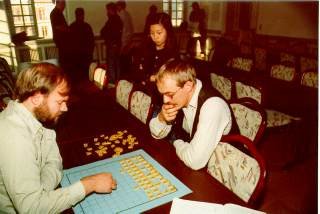Chu Shogi (Middle Shogi)
Chu Shogi is the most popular historical variant of Shogi other than the main nine by nine version that has survived until today. In fact, Chu Shogi is still being played in Japan and other countries today, with tournaments and commercially sold sets still available. It has been called the most well designed Great Chess game in the world being more enjoyable and interesting to play than most large variants.
There is no provision for returning captured pieces into play in Chu Shogi ; the game may therefore seem more familiar to players of the western game than modern Shogi.

SHORT DESCRIPTION:
Chu Shogi is played on a board of 12 x 12 squares and each player has 46 pieces (including 12 pawns).
The dominant – at least at the beginning of the game – piece is the Shishi (Lion). Each side has one to begin with, located just behind the Fuhyo line, meaning it has easy access to move to the center of the board quickly. The Shishi is an area mover but it is a very specialized area mover, extremely powerful in Chu Shogi. It appears in larger variants too but is not as powerful due to the increased size of the boards and the existence of other strong pieces. However, in Chu Shogi it is the principle attacking piece. Another strong piece is the Hon'o (Free King). It has the same moves as the Queen in modern western chess – the most powerful piece in that game – but is considered here as second to the Shishi.


 (From Steve
Evans)
(From Steve
Evans)
RULES:
The players make alternate moves, with the object being to capture the opposing King. If the opposing player has obtained a Crown Prince by promotion, that piece must also be captured in order to win the game. The game can also be won by capturing all pieces except the King (the "bare king" rule).
On each turn a player can move one piece according to its power of movement to a vacant square on the board, or to a square occupied by an enemy piece (in which case the enemy piece is captured and removed from the game).
In the case of the Lion and pieces with Lion power, a second move can sometimes be made in the same turn. The Lion has a very unusual move, and a number of special rules involving its capture. If the 8 squares immediately adjacent to the Lion are called the "A" squares , and the 16 squares two away from the piece are called the "B" squares, then the Lion may do anyone of the following things in a single turn :
-
Move directly to any "A" or "B" square, jumping an intervening square if necessary ;
-
Capture a piece on an "A" square and continue moving one more square in any direction from the point of capture, making another capture if the 2nd square is also occupied by an enemy piece.
-
Capture a piece on any "A" square without moving (this is known as igui and counts as a turn).
-
Move to an adjacent square and return to the starting square (effectively passing the turn). This move can be made by double-clicking the left mouse button on the Lion.
The following restrictions apply to the capture of Lions in Chu Shogi :
-
A Lion may capture an opposing Lion on a "B" square, only if it also made a capture on an "A" square (unless the captured piece was a Pawn or Go-Between), or if the opposing Lion is undefended.
-
If a player captures a Lion with a non-Lion piece, the opponent may not capture a Lion except with another Lion, on his next turn.
These rules ensure that the Lions which are the most powerful pieces in Chu Shogi are on the board for most of the game.
The Horned Falcon and Soaring Eagle also have Lion power, but only in some directions. There are no special rules concerning the capture of Horned Falcons or Soaring Eagles.
The Kylin and Phoenix (and those pieces with Lion powers) are the only pieces in Chu Shogi that have the power to jump over occupied squares. As indicated by red circles on the Piece Help screens, the Kylin can jump to the second square in any orthogonal direction, and the Phoenix may jump to the second square when moving diagonally.
The Drunk Elephant is potentially a very important piece, as it promotes to a Crown Prince. A player who gains a Crown Prince effectively acquires a second King as the Crown Prince must also be captured (or bared) before the opponent can win the game.
Promotion:
Each player has a Promotion Zone consisting of the four ranks (rows of squares) furthest away from him. All pieces except the King, Lion and Free King have a promoted rank and can promote on entering, moving within, or leaving the Promotion Zone. Promotion is not compulsory, but is subject to the following restrictions:
- If a piece does not promote on entering the Promotion Zone it may not promote on the next turn unless making a capture. The piece may, however, promote on any subsequent turn (as long as part of the move is within the Promotion Zone).
- If a Pawn is not promoted on entering the Promotion Zone, it must remain unpromoted until reaching the last (twelfth) rank, at which time it must promote.
- A Lance must promote on reaching the last rank (as it would otherwise have no further legal move).
As in all the games in the Shogi family, in Chu Shogi sets the promoted rank is shown on the reverse side of the piece, and the piece is turned over on promotion to reveal the new rank.
Capture:
Unlike in Shogi, captured pieces in Chu can not be dropped back into play. A captured piece is removed from play and takes no further part in the game.

Chu Shogi setting with westernized pieces
(drawings by JLC)
HISTORY:
Experts believe now that Chu Shogi (Middle or Intermediate Shogi) appeared in the 14th century as a simplification of Dai Shogi. It is first evoked in the Yűgaku ôrai, a text from 1350, along with Sho Shogi and Dai Shogi.
The next text which explicitly reports something about Chu Shogi would then be the Aro kassen monogatari of 1476. The text enumerates some Chu Shogi pieces but gives no details. Judging from many diaries it seems that Chu Shogi was more popular with noblemen and high-ranking monks. It seems reasonable to assume that Sho Shogi began to steeply rise in popularity after Sho Shogi began to be played with drops, becoming the modern Shogi. Thus this variant of Sho Shogi became the standard and a fierce competitor for Chu Shogi.






